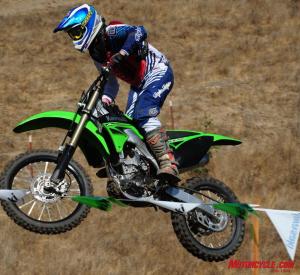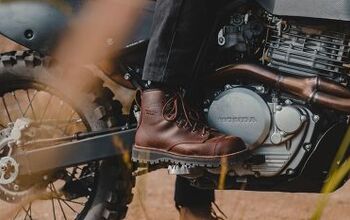2010 Kawasaki KX250F Review - Motorcycle.com
When a manufacturer has a proven motocross weapon in its stable, it sometimes becomes a serious gamble to start toying too deeply with it. That’s why Kawasaki’s approach to its lethal KX250F for 2010 is perhaps best reflected in the famous words of President Lyndon Johnson: “If it ain’t broke, don’t fix it.”
Based on the immense success of its 250 metal on the national scene, Kawasaki must have decided not to detour from their proven, race-winning platform and have focused its attention on subtle refinements to hone performance while extending durability, a kind of nip/tuck for 2010.
For starters the KX’s 249cc, liquid-cooled, 4-stroke single-cylinder DOHC, 4-valve powerplant has received a number of refinements that enhance an already potent package. Making its first appearance in a mass-production motorcycle, the KX250F receives a “bridged-box bottom” race-inspired piston, which is lighter and stronger due supporting ribs that reinforce the piston pin shaft. The new piston has a shorter skirt and narrower piston pin to reduce reciprocating mass, resulting in a quicker revving motor. The piston’s crown has been reshaped, adding 0.6mm in height to improve combustion with the cylinder height increased slightly to maintain a 13.2:1 compression ratio.
A new exhaust pipe – made from stainless steel for increased durability – is comprised of a longer head pipe married to a shorter mid-section to boost low-rpm performance. The pipe/muffler joint and clamp has been modified to improve exhaust seal while the tail of the muffler is rubber-mounted for shock absorption.
Kawasaki implemented an “electrofusion treatment” on the cylinder bore for better oil retention and less scorching, thus making the top-end more resistant to seizing. These top-end changes, coupled with new, wider (from 5mm to 5.5mm) oil pump rotors – that have increased oil flow by 10% – and a wider big-end rod bearing are specifically aimed at extending engine life and increasing reliability. The technicians at Kawasaki boast that they’ve gotten the KX’s crankshaft balance closer to that of the factory racers, resulting in less vibration, which translates into smoother throttle response.
The 250 (like its big brother KX450F gets larger, wider radiators with a fin pitch designed to accumulate less mud. The increased rigidity of the new radiators allows the reinforcing brackets and support stays to be removed, resulting in reduced overall radiator weight.
On the transmission end, beefier dogs were added to the 3rd and 4th input gears to reduce wear while the circlip and washer of the 4th input gear holding method was eliminated by redesigning the 2nd input gear to carry the weight load instead of the washer. The result of these changes is increased precision of the shifts with added strength and durability. The five-speed transmission enlists the same ratios as last year. Crankcases have been thickened overall with added material at crucial engine mounting holes.
The main chassis mods for 2010 are a decreased diameter steering stem and redesigned swingarm. By reducing the size of the steering stem – from 24mm to 23mm – rigidity is reduced, theoretically giving the bike a slightly lighter feel in handling. This same theory applies to the swingarm, with the overall wall thickness being reduced and coupled with a reworked, less gussetted cross section designed to lower rigidity, which ultimately contributes to a lighter handling machine by allowing some flex.
As for the basic numbers (as per Kawasaki’s press material), seat height is 37.6 inches. Wheelbase is at 57.9-inches. Ground clearance is 13.4-inches and the claimed curb weight (a.k.a. “wet”) is 231.4 pounds.
Showa twin-chamber forks have titanium-coated lower tubes that reduce friction for smoother response. The 16-way compression and rebound damping adjustments augment 12.4 inches of fork travel. The damping settings are new, with less forward lean that lends more balance in the bike’s front to rear attitude. The new damping settings on the Showa rear shock combined with the new rocker arm are implemented to reduce kicking on corner entry. The rear shock possesses 13-way low-speed and stepless high-speed compression damping with 17-position rebound damping and fully adjustable spring preload, providing 12.2 inches of rear wheel travel.
Enough with the walk-around. It was time to turn a wheel on the 2010 KX250F. We enlisted the services of Intermediate-level racer Parker Jones to flog the Kawasaki around the private Castillo Ranch Motocross track in Central California. At 16 years-old, Jones stands 5-foot-11-inches tall and weighs 165 pounds. The first comment Jones made upon seeing the 2010 KX was that the black forks and highlights were “cool.” The tenth grader has been racing for four years and, though polite and soft-spoken in the pits, he thoroughly put the new Kawasaki through its paces on the track.
As the sun dried out some of the over-watered sections, Parker quickly learned the layout of the track and started putting in the laps. Castillo Ranch is a decent test facility, laced with a challenging mix of off-cambers, sand, hard-pack, uphills, downhills and a killer whoop section with truly man-sized ruts that are far from uniform, resulting in a real test of a bike’s stability in ugly, nasty ruts. An initial tendency of the front end to get skittish was solved by backing off the compression a few clicks. From that point forward the bike exhibited the high-speed stability it’s known for, especially in those serious whoops.
Parker was immediately impressed by the KX’s power, in terms of both abundance and delivery. The bike manages to produce a strong pull from right off the bottom all the way to the rev limiter. Kawasaki was rumored to be going fuel-injected this year on the 250 but have elected to stay with carburetion.
The KX tracked superbly anytime the throttle was whacked, getting its horsepower hooked up with minimal wheelspin whether in the sand or the hard pack. As for cornering, Parker said the bike worked equally well whether railing a berm or taking the point-and-shoot approach to a corner. The bike responded well to rider input, going where the rider wants it to without a fight.
The front brake took a little getting used to due its grabbiness, but Parker said once he acclimated to the sensitivity it was fine. Although the rear brake (fitted with upgraded pad material) worked decently, Jones commented on squeaking noises on corner entry. Upshifts and downshifts were positive with or without the clutch and regardless of being on or off the throttle. The bike’s attitude in the air is predictable with no scary tendencies, and the suspension handled all the big jumps smoothly – even when coming up a little short.
At the end of the day Parker Jones was wearing a big grin, the kind that only comes when you’ve thoroughly enjoyed yourself. He had virtually nothing negative to say about the new bike. The $6,999 MXer does everything it needs to, exceptionally well. The 2010 Kawasaki KX250F is a more refined, focused, and durable machine from its worthy predecessor.
Having reached a point of superlative engine performance and handling, the company felt it best to merely augment what has been a proven winner on the track. With all of Team Green being healthy for the coming indoor and outdoor Lites season, it’s a pretty good bet that Kawasaki will be visiting the podium on a regular basis in 2010.
Related Reading
2010 Kawasaki KX450F Review
2009 Kawasaki KX250F Review
More by Jeff Buchanan

































Comments
Join the conversation